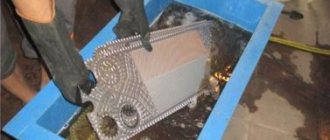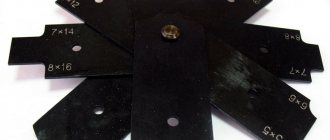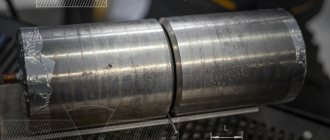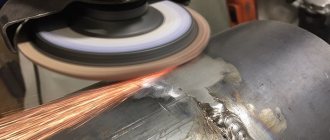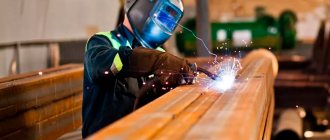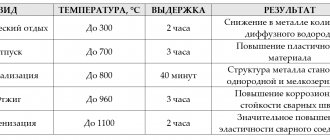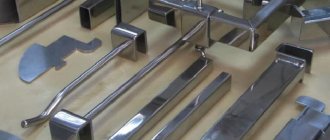Article updated and supplemented: April 18, 2021
If you are interested in stainless steel weld cleaning services, please fill out the form below .
Welding is a reliable and popular method of joining metal parts. It has pros and cons that can either improve or ruin all the work done. To reduce the likelihood of defects occurring, different methods are used to clean welds on stainless steel.
Purposes of Cleaning Stainless Steel Welds
Stainless steel products are used in various industrial and household sectors. The main difference of this material is its high corrosion resistance compared to ordinary metal. Stainless steel is reliable in daily use; finished items can last a long time.
Welding has a much greater impact on the connection of metal parts than it seems. During the welding process, a large internal stress arises in the part being manufactured, due to which it becomes plastic and can subsequently be deformed. Welding degrades the properties of metals due to uneven heating. This leads to disruption of the crystal lattice of the material.
Eliminating defects can restore lost properties to stainless steel. Treatment of seams after welding has a positive effect on corrosion resistance
. Good cleaning reduces the risk of corrosion and rust.
You can get the best quality of the finished product by properly processing the seams after welding. If the technology is broken, the connection may darken and even rust. Accordingly, the product will quickly fail.
Immediately after welding, the finished seams are dark or colored. Tarnish colors are formed when alloying elements heat up and burn out from the surface of stainless steel. Therefore, the metal joints must be properly processed. Aesthetic presentation
- the purpose of the seam cleaning procedure.
Acids and gels
To remove all color transitions after welding and eliminate the oxide layer that promotes corrosion, stainless steel is etched. This refers to the acidic type of material treatment. You can use sulfuric or hydrochloric acid. Analogs, such as fluoride or nitrogen, are also suitable. They are available in the form of gels and pastes. There are also special aerosols. The procedure goes like this:
- After welding, scale and debris are removed from the surface. A metal brush is used for this.
- The product is allowed to cool to a temperature of 50 degrees.
- The composition is applied from above or the structure is immersed in a container with an acidic agent.
- After 30 minutes, wash off the acid with plenty of water.
It is important for the worker to wear a respirator, since there will be a large amount of vapor in the air that is dangerous to the respiratory system. It is also necessary to protect the skin on your hands by wearing rubber gloves. If acid comes into contact with an open area of skin, rinse the area quickly and thoroughly with plenty of water.
Another processing method is electrochemical etching. To do this, use a container with acid. Two wires emanate from the current source, which are placed into the liquid through a resistance. The product is attached to the “plus”, which consists of a lead plate. The “minus” of the lead plate drops freely into the acid. Closing the voltage in the composition promotes the separation of oxides from the surface of the stainless steel, but prevents oversaturation of hydrogen. The procedure lasts up to 8 minutes.
Thanks to a variety of methods for processing stainless steel, you can achieve a beautiful appearance at the welding site. This is a painstaking process that requires diligence and perseverance, but thanks to such measures, a mirror-like surface is created that will not rust in the future due to the weak oxide layer.
Methods for cleaning stainless steel welds
Processing welding seams is a labor-intensive process that requires special skills from a specialist, as well as the use of professional tools.
First, decide on how to clean the seams. There are several ways to process welds. They differ from each other in stripping technology, cost and safety. It is impossible to say which one is better or worse, because each method has its own advantages and disadvantages. Each method is useful in its own way. It often happens that methods of processing welding seams are combined.
Here is a comparison table of the pros and cons of the main methods for cleaning stainless steel welds.
Let's take a closer look
main options for cleaning stainless steel welds.
Mechanical/abrasive cleaning of the weld seam
A simple and budget option for abrasive cleaning - manual method
. It is done using a wire brush and grinding wheels. It is not the best method, because it takes a lot of time, especially if the task is to polish the surface.
It is much easier and more convenient to clean using professional equipment: a portable polishing machine or grinder.
Equipment for cleaning seams after welding on stainless steel
A lot depends on the choice of equipment, tools and consumables. Properly selected equipment will allow you to achieve the highest quality results.
When choosing grinding equipment, pay attention to the power of the device
, because the speed of cleaning the welds on the product from the consequences of welding will depend on it. Only then take into account the electricity consumption indicators.
Grinding equipment can be portable or stationary. It is designed to eliminate defects after welding. When choosing devices for processing metal surfaces, take into account the volume of products produced and the actual size of the parts being manufactured.
Note! For high-quality processing, the grinder should be equipped with a flap sanding attachment or an abrasive wheel. Want to get better results? Then use a fabric base for the petal coated with aluminum zirconate. The use of fabric nozzles reduces the possibility of corrosion and rust on welding seams.
Abrasive cleaning of metal joints allows you to get rid of scale, oxides, burrs and traces of tarnish. To achieve maximum mirror-like shine on the surface, change the nozzles successively, gradually reducing the grain size. During processing, it is necessary to clean the entire surface, especially in hard-to-reach places: corners, holes, thin edges. High-quality grinding can be achieved using special burr tools. They are easy to install into a straight grinder.
It is not recommended to violate the stages of cleaning and grinding the weld seam. For high-quality results, follow the following sequence:
- Cleaning the area around the seam;
- Rough stripping;
- Polishing.
The first stage involves the removal of scale, slag and tarnish. Next, the structure of the seam is leveled until the weld disappears. The final stage will be polishing the welding product and preparing for painting.
The mechanical method of processing seams is accessible to many, as it does not require the use of special equipment. Many craftsmen prefer this method of cleaning welding seams, because it is less energy-consuming.
Important! Choose the right grinding wheel, otherwise the finished result may disappoint you.
The best material for processing welds on stainless steel is aluminum zirconate. It has several advantages over aluminum oxide: it does not cause corrosion and is more durable.
Pros and cons of abrasive cleaning of stainless steel welds
The abrasive method has such advantages as:
- good seam processing speed;
- versatility of use;
- convenience of technology;
- no need for special waste disposal.
The disadvantages of the method include:
- removing only traces of tarnish;
- cost of equipment, high labor costs;
- Can only be used by a qualified specialist;
- inability to carry out the stainless steel passivation procedure;
- non-uniform metal surface after processing, the need to polish the weld.
Important! Most parts must undergo mechanical seam cleaning before painting.
Chemical cleaning of stainless steel welds
To achieve the best possible result of seam processing after welding, a combination of mechanical and chemical cleaning methods is used.
The chemical effect on metal is carried out in two stages: etching and passivation.
Pickling of stainless steel welds
The stainless steel etching methods we use are described in more detail in the article “Etching and passivation of stainless steel.”
The initial stage of cleaning the weld joint and heat-affected zone is etching. Etching can completely remove tarnish and inclusions from a metal surface using chemicals containing acids. Using this method you can get rid of areas with tarnish.
Small seams are treated pointwise, that is, the product is applied to the place where cleaning is required. Sometimes, to achieve a good result, the part is completely immersed in the solution and left for several hours - the immersion method is used. The time is calculated individually for each individual part and steel grade.
Passivation of stainless steel welds
You can find out more about what passivation is in our review article “Metal passivation”.
The second stage is passivation. It is performed after etching to restore the alloying layer on the surface. It is this layer that is the main reason for the corrosion resistance of stainless steel.
Passivation involves the use of chemicals whose task is to form a protective film at the joint. After passivation, the surface has anti-corrosion properties, therefore, the reliability of the finished product increases.
Important! The use of chemicals implies their complete removal from the surface of the product and proper disposal of waste.
Chemical cleaners for welding seams
For proper etching and passivation, seam stripping agents are used that are used in different operating conditions.
Pickling baths:
designed for immersing products in a solution containing various acids.
Spray gels:
used for processing large surfaces.
Etching pastes:
used to remove slag, scale and oxides.
Important! Dispose of wastewater after chemical treatment. The use of special products implies a large amount of acids and heavy metals in the water. This can have a negative impact on the environment and the condition of living organisms. Neutralize the acid with alkali, filter the waste and dispose of it in accordance with Russian legislation.
Pros and cons of chemical cleaning of stainless steel welds
The advantages of this method of processing welds include its efficiency and low cost of purchasing etching agents. However, there are also a number of serious disadvantages:
- Chemicals harm the employee and the environment;
- Whitish spots may remain on the surface of the part;
- It takes a lot of time to process a part;
- There is no possibility of polishing the seam;
- The need for an additional passivation procedure for stainless steel;
- Difficult waste disposal.
“Metal Cleaner” uses its own chemicals in its work. The weld cleaning cycle is as follows:
- Degreasing using SteelGuard MultiClean degreaser;
- Dip etching (SteelGuard InoxClean) or spray etching (SteelGuard InoxClean Spray);
- Passivation by immersion (SteelGuard InoxPass) or spray method (SteelGuard InoxPass Spray).
Electrochemical cleaning of stainless steel welds
This procedure allows you to influence not only the seam, but also the adjacent surface. It is carried out using electric current and specially developed electrolytes, which carry out the stages of etching, passivation and polishing.
Thanks to the electrolyte, it becomes possible to remove tarnished colors. Electrochemical treatment allows you to preserve the appearance of the weld.
If the surface was mirror/matte/polished, then it remains that way. After the procedure, a passive layer is restored on the seam, which subsequently provides anti-corrosion properties.
The use of technology will help reduce labor costs for employees and prevent the appearance of defects on parts. The appearance of the product after polishing remains salable.
Pros and cons of electrochemical cleaning of stainless steel welds
The electrochemical method of cleaning welds is the most effective in our time.
Today, its advantages stand out significantly among its competitors.
Its main advantages:
- High (instant) cleaning speed;
- Carrying out passivation of stainless steel in parallel with cleaning the weld;
- Low labor costs;
- Safe technology of use;
- No need for waste disposal;
- Polishing the weld and thereby giving the product a marketable appearance.
This technology has only one drawback: the high cost of the equipment, which pays off within 6-12 months.
SteelGuard Weld Seam Cleaners
SteelGuard equipment
– devices for electrochemical cleaning of metal surfaces, high-quality etching and passivation processes. They are considered universal devices for use in medium and large enterprises.
The Steelguard 685 is a high-performance device for electrochemical cleaning of seams after welding. Due to its high power, the device is capable of cleaning welds at a speed of 2-5 linear meters per minute. Functions performed: etching, passivation, polishing and marking. No highly toxic etching agents are required for cleaning. Provides preservation of the appearance of the part.
The SteelGuard 425 Weld Cleaner is a simplified version of the SteelGuard 685. It is more portable, making it a more versatile option.
You can see the device for electrochemical cleaning of welds SteelGuard 685 in action in our case from the Gamma Design Bureau: “How we speed up the processing of welds by 3 times.”
Laser cleaning of stainless steel welds
Laser resurfacing
- non-contact method. The laser provides an effective and clean cleaning area.
Laser polishing of stainless steel is environmentally friendly and does not involve the use of consumables. Due to the compactness of the equipment, the laser tool can be moved to different rooms.
Cleaning welds with a laser is quick, but the method is very expensive.
Pickling baths
Dip pickling of stainless steel is suitable for small to medium-sized parts. The products are completely immersed in a bath of etching solution. Pickling and passivation of stainless steel is carried out over the entire surface of the metal. Means for pickling stainless steel using this method are divided into two basic types:
- Formulations based on nitric acid, which are particularly quick and easy to use;
- Solutions that do not contain nitric acid, which are safer, more productive and easier to dispose of.
All products are offered for purchase in concentrated form or as ready-to-use solutions.
Safety precautions
Before starting work on cleaning welding joints on stainless steel, you must make sure that the workplace and special clothing are ready. Be sure to check the equipment. You can begin work only with all the protective equipment necessary for a welder.
Periodically, the employee is required to undergo training and instructions on compliance with fire safety rules. Information about briefings is displayed in the work log under the employee’s signature.
Primary requirements:
- You cannot be distracted while processing welding seams;
- There should be no flammable objects in the room;
- Effective ventilation;
- The equipment can only be moved after the power supply has been turned off;
- Only serviceable equipment may be used;
- When carrying out a chemical or electrochemical method, it is necessary to ensure proper disposal of the products.
Mechanical grinding
Stainless steel is characterized by the presence of a high level of corrosive properties, which determine its active use in environments where liquids are often used. Although products made from such material are in active contact with water and are subject to preliminary welding, their appearance does not change significantly over time. This feature can be traced as a result of the use of certain processing principles.
Among the main processing options, it is customary to highlight mechanical grinding of stainless steel after welding. During this process, the top layer of the oxide component that forms at the welding site and represents a weak point in the entire structure is eliminated. Distinct color transitions and existing irregularities in the weld joint are also eliminated.
This process is characterized by the following sequence:
- eliminating waves in the area of the metal seam by using a thick grinding wheel and grinder, as well as leveling out any bulges present;
- using petal circles for the functioning of the grinder; the main goal of such elements is to carry out work more accurately, along with longer process times and consumption of materials, which is especially important for large-scale work;
- the use of a specially designed equipment complex in the form of a grinding machine, the result of which is a one-color matte coating;
- mandatory use of a respirator to reduce the risk of abrasive dust and metal particles entering the respiratory tract that are in the air during work.
Convenient etching using spray gels
Pickling and passivation of stainless steel in a bath by immersion is not always possible, for example in cases where large and very large surfaces are required. When working with large-sized products, more convenient etching compositions in the form of gel sprays are used. Etching gel sprays are also used to treat the surface of stainless steel products that need to be treated externally only, as well as those that cannot be transported and must be treated on site.
Etching gel sprays are applied by spraying onto the surface to be treated. Gels are liquid and can be sprayed onto large surfaces of workpieces. Due to their high viscosity, they literally stick to the metal surface and thus produce an etching effect.
In addition to standard products for a wide range of materials, FORSTEX offers the following types of etching gels:
- Gel spray with soft etching effect;
- Gel with reduced release of nitrogen oxides;
- Gels with indicators;
- Colored etching gels for optimal surface finish visibility.
